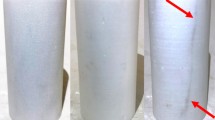Summary
When considering the fracture resistance of high strength casing that may be used for deep gas well interests onshore or offshore, it is important that the casing meet minimum performance criteria. With this in mind, a program surveying the strength and fracture resistance limits of high strength low alloy casing steels was undertaken. Fracture mechanics concepts were used to define minimum required casing steel fracture toughness. Results showed many of the available high strength casing grades with inadequate fracture resistance. To provide high strength casing with sufficient fracture resistance, a fracture control plan was developed. At the start, the low energy ductile tearing model was applied relating fracture toughness to cleanliness and sulfur content. A criterion for casing steel selection with sufficient fracture toughness was developed providing needed reliability. This criterion is applied, using normal mill inspection as required in the API casing specifications, a Charpy impact test, and the sulfur cleanliness level.
Similar content being viewed by others
References
T. W. Hamby, “Development of High-Pressure Sour Gas Technology,” Journal of Petroleum Technology, Volume 33, No. 5, 1981.
International Metallurgical Reviews, “The Melting Practices in Steel Making,” Volume 3, 1978.
API Specifications, 5A—Casing Tubing and Drill Pipe, 5AC—Restricted Yield Strength Casing and Tubing, 5AX—High Strength Casing, Tubing and Drill Pipe, American Petroleum Institute, 1980.
Barsom and Rolfe, Fracture and Fatigue Control in Structures, Prentice Hall, 1977.
Tetelman and McEvily, Fracture of Structural Materials, John Wiley & Sons, 1967.
MacKenzie, Hancock, and Brown, “Influence of State of Stress on Ductile Failure Initiation in High Strength Steels,” Engineering Fracture Mechanics, Volume 9, pp 167–188, 1977.
Ritchie, Sever and Wullaert, “Critical Fracture Stress and Fracture Strain Models for Prediction of Lower and Upper Shelf Toughness in Nuclear Pressure Vessel Steels,” Metallurgical Transactions A, 10, 1979.
ASM Handbook Volume 8, “Metallography Structures and Phase Diagrams,” 8th Edition.
Author information
Authors and Affiliations
Additional information
Dr. James D. Burk received his Ph.D. in Metallurgical Engineering from the University of Illinois-Urbana.
Rights and permissions
About this article
Cite this article
Burk, J.D. Fracture Resistance of Casing Steels for Deep Gas Wells. JOM 37, 65–70 (1985). https://doi.org/10.1007/BF03257518
Published:
Issue Date:
DOI: https://doi.org/10.1007/BF03257518




